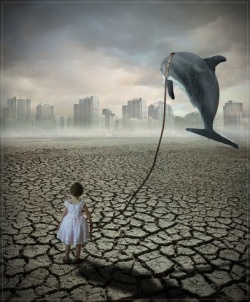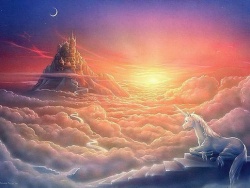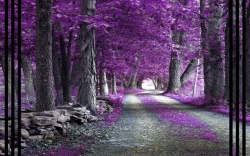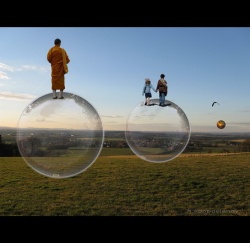Difference between revisions of "Shangri-La"
(Created page with "Shangri-La is a fictional place described in the 1933 novel Lost Horizon by British author James Hilton. Hilton describes Shangri-La as a mystical, harmonious valley, gently g...") |
m (Text replacement - "illustrated" to "illustrated") |
||
| (8 intermediate revisions by 2 users not shown) | |||
| Line 1: | Line 1: | ||
| − | Shangri-La is a fictional place described in the 1933 novel Lost Horizon by British author James Hilton. Hilton describes Shangri-La as a mystical, harmonious valley, gently guided from a lamasery, enclosed in the western end of the Kunlun Mountains. Shangri-La has become synonymous with any earthly paradise but particularly a mythical Himalayan utopia — a permanently happy land, isolated from the outside world. In the novel Lost Horizon, the people who live at Shangri-La are almost immortal, living years beyond the normal lifespan and only very slowly aging in appearance. The word also evokes the imagery of exoticism of the Orient. In the ancient Tibetan scriptures, existence of seven such places is mentioned as Nghe-Beyul Khimpalung.[ | + | [[File:Ation-1.jpg|thumb|250px|]] |
| + | '''[[Shangri-La]]''' is a fictional place described in the 1933 {{Wiki|novel}} Lost Horizon by {{Wiki|British}} author James Hilton. Hilton describes [[Shangri-La]] as a [[mystical]], harmonious valley, gently guided from a [[lamasery]], enclosed in the {{Wiki|western}} end of the [[Kunlun Mountains]]. [[Shangri-La]] has become {{Wiki|synonymous}} with any [[earthly]] [[paradise]] but particularly a [[mythical]] [[Himalayan]] utopia — a permanently [[happy]] land, isolated from the outside [[world]]. In the {{Wiki|novel}} Lost Horizon, the [[people]] who [[live]] at [[Shangri-La]] are almost [[immortal]], living years [[beyond]] the normal lifespan and only very slowly [[aging]] in [[appearance]]. The [[word]] also evokes the [[imagery]] of exoticism of the {{Wiki|Orient}}. In the {{Wiki|ancient}} [[Tibetan]] [[scriptures]], [[existence]] of seven such places is mentioned as [[Nghe-Beyul Khimpalung]]. [[Khembalung]] is one of several [[beyuls]] ("[[hidden lands]]" similar to [[Shangri-La]]) believed to have been created by [[Padmasambhava]] in the 8th century as idyllic, [[sacred]] places of [[refuge]] for [[Buddhists]] during times of strife (Reinhard 1978). | ||
| − | The use of the term Shangri-La is frequently cited | + | The use of the term [[Shangri-La]] is frequently cited as a {{Wiki|modern}} reference to [[Shambhala]], a [[mythical]] {{Wiki|kingdom}} in [[Tibetan]] [[Buddhist]] [[tradition]], which was sought by Eastern and {{Wiki|Western}} explorers. |
| − | |||
| − | |||
| + | The [[phrase]] "[[Shangri-La]]" most probably comes from the [[Tibetan]] {{BigTibetan|[[ཞང་]]}},"[[Shang]]" - a district of [[Ü-Tsang,]] [[north]] of [[Tashilhunpo]]" + {{BigTibetan|རི}}, pronounced "[[ri]]", "[[Mountain]]" = "[[Shang Mountain]]" + {{BigTibetan|[[ལ]]}}, [[Mountain Pass]], which suggests that the area is accessed to, or is named by, "[[Shang Mountain Pass]]" | ||
| + | [[File:000-1000.jpg|thumb|250px|]] | ||
Location | Location | ||
| − | Several places in the Himalaya in Nepal have claimed to be the location for Hilton's fictional Shangri-La, largely to attract tourism | + | Several places in the [[Himalaya]] in [[Nepal]] have claimed to be the location for Hilton's fictional [[Shangri-La]], largely to attract tourism. |
| − | |||
| − | |||
| − | |||
| − | |||
| − | |||
| − | |||
| − | + | In [[China]], the poet [[Tao Yuanming]] ([[陶淵明]]) of the [[wikipedia:Jin Dynasty (265-420)|Jin Dynasty]] (265–420) described a kind of [[Shangri-La]] in his work [[The Tale of the Peach Blossom Spring]] (simplified {{Wiki|Chinese}}: [[桃花源记]]; {{Wiki|traditional Chinese}}: [[桃花源記]]; pinyin: [[Táohuā Yuán Jì]]). The story goes that there was a fisherman from Wuling, who came across a beautiful peach grove, and he discovered [[happy]] and content [[people]] that lived completely cut off from the troubles in the outside [[world]] since the {{Wiki|Qin Dynasty}} (221–207 BCE). In {{Wiki|modern}} [[China]], the [[Zhongdian]] county was renamed to [[Xiānggélǐlā]] ([[香格里拉]], [[Shangri-La]] in {{Wiki|Chinese}}) in 2001, to attract tourists. The legendary [[Kun Lun Mountains]] ([[崑崙山]]) offer another possible place for the [[Shangri-La]] valleys. | |
| − | + | A popularly believed [[physical]] inspiration for Hilton's [[Shangri-La]] is the [[Hunza]] Valley in northern {{Wiki|Pakistan}}, close to the {{Wiki|Chinese}} border, which Hilton visited a few years before [[Lost Horizon]] was published. Being an isolated green valley surrounded by [[mountains]], enclosed on the {{Wiki|western}} end of the [[Himalayas]], it closely matches the [[physical]] description in the {{Wiki|novel}}. A [[Shangri-La]] resort in the nearby Skardu valley is a popular tourist [[attraction]]. The [[Hunza]] Valley, however, lacks [[Tibetan]] {{Wiki|culture}} and the [[Buddhist]] [[religion]], so could not have been Hilton's {{Wiki|cultural}} inspiration for Lost Horizon. | |
| + | [[File:311094.jpg|thumb|250px|]] | ||
| + | The {{Wiki|cultural}} [[representation]] of [[Shangri-La]] is most often cited to be northwestern {{Wiki|Yunnan}} Province, [[China]], where National Geographic explorer Joseph Rock lived and traveled during the 1920s and early 1930s and wrote several articles in National Geographic magazine that are richly illustrated with superb photography. This coincides with the [[time]] when James Hilton would have been [[writing]] Lost Horizon, but there is no direct {{Wiki|evidence}} to support this claim. The {{Wiki|evidence}} points to another set of explorers. In a {{Wiki|New York}} Times interview in 1936, Hilton states that he used “[[Tibetan]] material” from the {{Wiki|British Museum}}, particularly the travelogue of two {{Wiki|French}} {{Wiki|priests}}, Evariste Regis Huc and [[Joseph Gabet]], to provide the [[Tibetan]] {{Wiki|cultural}} and [[Buddhist]] [[spiritual]] inspiration for [[Shangri-La]]. Huc and Gabet travelled roundtrip between [[Beijing]] and {{Wiki|Lhasa}} in 1844–46 on a route more than 250 km [[north]] of {{Wiki|Yunnan}}. Their famous travelogue, first published in {{Wiki|French}} in 1850,[7] went through many editions in many [[languages]]. A popular “condensed translation” was published in {{Wiki|England}} in 1928,[9] at the [[time]] that Hilton would have been getting inspired for — or even [[writing]] — Lost Horizon. | ||
| − | + | Today, various places claim the title, such as parts of southern [[Kham]] in northwestern {{Wiki|Yunnan}} province, including the tourist destinations of [[Lijiang]] and Zhongdian. Places like {{Wiki|Sichuan}} and [[Tibet]] also claim the {{Wiki|real}} [[Shangri-La]] was in its territory. In 2001, {{Wiki|Tibet Autonomous Region}} put forward a proposal that the [[three regions]] optimise all [[Shangri-la]] tourism resources and promote them as one. After failed attempts to establish a [[China]] [[Shangri-la]] {{Wiki|Ecological}} Tourism Zone in 2002 and 2003, government representatives of {{Wiki|Sichuan}} and {{Wiki|Yunnan}} provinces and {{Wiki|Tibet Autonomous Region}} signed a declaration of cooperation in 2004. Also in 2001, Zhongdian County in northwestern {{Wiki|Yunnan}} officially renamed itself [[Shangri-La]] County. | |
| − | + | [[Bhutan]], which until 1999 was largely isolated from the outside [[world]] and has its unique [[form]] of [[Buddhism]], has been hailed as the last [[Shangri-La]]. | |
| + | [[File:61853-1024-768.jpg|thumb|250px|]] | ||
| + | Another place that has been [[thought]] to have inspired the {{Wiki|concept}} of [[Shangri-La]] is the [[Yarlung]] {{Wiki|Tsangpo}} Grand Canyon. | ||
| − | + | Television presenter and historian Michael [[Wood]], in the "[[Shangri-La]]" episode of the PBS documentary series In Search of [[Myths]] and Heroes, suggests that the legendary [[Shangri-La]] is the abandoned city of [[Tsaparang]] in upper Satluj valley, and that its two great [[temples]] were once [[home]] to the [[kings]] of [[Guge]] in {{Wiki|modern}} [[Tibet]]. It is speculated that [[Sang-la]], Chitkul in Sangla valley near Indo-Tibet Border is [[Shangri-la]]. La in spiti/Kinnauri like in [[Tibetan Language]] is [[word]] for Mountain pass. Kamru Village in Sangla was the {{Wiki|ancient}} {{Wiki|capital}} of Bushahr which was a [[Buddhist]] state until conquered by [[Gurkhas]]. | |
| − | + | American explorers Ted Vaill and Peter Klika visited the Muli area of southern {{Wiki|Sichuan Province}} in 1999, and claimed that the Muli [[monastery]] in this remote region was the model for James Hilton's [[Shangri-La]], which they [[thought]] Hilton learned about from articles on this area in several National Geographic magazine articles in the late 1920s and early 1930s written by Austrian-American explorer Joseph Rock. Michael McRae unearthed an obscure James Hilton interview from a {{Wiki|New York}} Times {{Wiki|gossip}} column where he reveals his {{Wiki|cultural}} inspiration for [[Shangri-La]] and, if it is any place, it is more than 250 km [[north]] of Muli on the route travelled by Huc and Gabet. Vaill completed a film based on their research, "Finding [[Shangri-La]]", which debuted at the Cannes Film {{Wiki|Festival}} in 2007. | |
| − | Modern usage | + | On December 2, 2010, OPB televised one of Martin Yan's Hidden [[China]] episodes "[[Life]] in [[Shangri-La]]", in which Yan said that "[[Shangri-La]]" is the actual [[name]] of a {{Wiki|real}} town in the hilly and mountainous region in northwestern {{Wiki|Yunnan}} Province, frequented by both Han and [[Tibetan]] locals. Martin Yan visited [[arts]] and craft shops, local {{Wiki|farmers}} as they harvest crops, and sampled their cuisine. |
| + | [[File:99917-1920-1200.jpg|thumb|250px|]] | ||
| + | {{Wiki|Modern}} usage | ||
| − | here are a number of modern Shangri-La pseudo-legends that have developed since 1933 in the wake of the novel and the film made from it. The Nazis had an enthusiasm for Shangri-La, where they hoped to find an ancient master race similar to the Nordic race, unspoiled by Buddhism. They sent one expedition to Tibet, led by Ernst Schäfer in 1938. | + | here are a number of {{Wiki|modern}} [[Shangri-La]] pseudo-legends that have developed since 1933 in the wake of the {{Wiki|novel}} and the film made from it. The {{Wiki|Nazis}} had an [[enthusiasm]] for [[Shangri-La]], where they hoped to find an {{Wiki|ancient}} [[master]] race similar to the Nordic race, unspoiled by [[Buddhism]]. They sent one expedition to [[Tibet]], led by Ernst Schäfer in 1938. |
| − | Another pseudo-legend involves the Ojai Valley as the location for the 1937 Frank Capra film Lost Horizon. The outdoor scenes of the villagers of Shangri-La and a cavorting Ronald Colman and Jane Wyatt were in fact filmed in nearby Sherwood Forest (Westlake Village) and Palm Springs. The exterior of the grand lamasery was built and later dismantled on the Columbia Ranch in Burbank, California. | + | Another pseudo-legend involves the Ojai Valley as the location for the 1937 Frank Capra film Lost Horizon. The outdoor scenes of the villagers of [[Shangri-La]] and a cavorting Ronald Colman and Jane Wyatt were in fact filmed in nearby Sherwood {{Wiki|Forest}} (Westlake Village) and Palm Springs. The exterior of the grand [[lamasery]] was built and later dismantled on the Columbia Ranch in Burbank, {{Wiki|California}}. However, according to film historian Kendall Miller in the photo documentary bonus feature on the "Lost Horizon" DVD, an aerial shot of Ojai Valley taken from an outlook on Highway 150 was used to represent the [[Shangri-La]] valley. |
| − | United States President Franklin Delano Roosevelt, being considerably fond of Hilton's novel, named the presidential retreat, now known as Camp David, "Shangri-La" in 1942. After the Doolittle Raid on Tokyo in April 1942, when asked where the bombers came from, he quipped "Shangri-La". Later in the war, the United States Navy would launch an Essex-class aircraft carrier named the Shangri-La (CV-38), as a result of this reference. | + | [[United States]] President Franklin Delano Roosevelt, being considerably fond of Hilton's {{Wiki|novel}}, named the presidential [[retreat]], now known as Camp David, "[[Shangri-La]]" in 1942. After the Doolittle Raid on {{Wiki|Tokyo}} in April 1942, when asked where the bombers came from, he quipped "[[Shangri-La]]". Later in the [[war]], the [[United States]] Navy would launch an Essex-class aircraft carrier named the [[Shangri-La]] (CV-38), as a result of this reference. |
| + | [[File:Oppdelaney.jpg|thumb|250px|]] | ||
| + | In 1937, Lutcher Stark, a Texas {{Wiki|philanthropist}}, started building his own [[Shangri-La]] in Orange, Texas. His [[Shangri-La]] was an azalea garden situated alongside a cypress-tupelo swamp. By 1950, thousands of [[people]] were traveling to Orange to visit [[Shangri La]], and many magazines published photographs of it. In 1958, a major snowstorm struck [[east]] Texas destroying thousands of azaleas and closing the garden for 40 years. The garden has recently been renovated and is now open to the public once again. | ||
| − | + | Trouble in [[Shangri-La]] (2001) is the title of the sixth studio album by American singer-songwriter and Fleetwood Mac vocalist Stevie Nicks. | |
| − | + | Escape from [[Shangri-La]] is the title of a 1998 {{Wiki|novel}} for children by {{Wiki|British}} author, Michael Morpurgo. | |
| − | + | Glastonbury {{Wiki|Festival}} created an after-hours area within the site called [[Shangri-La]] in 2009. It has evolved over the {{Wiki|past}} three years each with a slightly different theme: In 2009 the socialist utopia became a dystopian [[pleasure]] city run by a corrupt regime. In 2010 the ruling administration was overthrown and the city was opened up to rebels and chancers to carve out their own little piece of [[paradise]]. The 2011 storyline is pre-apocalyptic — the population of [[Shangri–La]] is preparing to flee to before the end of the [[world]] in 2012. | |
| − | + | In 2006, the International Astronomical Union named the equatorial, dark, low-lying area of Saturn's [[moon]] {{Wiki|Titan}} [[Shangri-la]]. | |
| − | In | + | In the 2008 film Mummy: Tomb of the [[Dragon]] [[Emperor]] a "[[Shangri-La]] Stone" is used by the [[Dragon]] [[Emperor]] in order to find the location of [[Shangri-La]] and drink from the Pool of [[Eternal Life]] so he can raise his {{Wiki|army}} from the [[dead]]. |
| − | + | The rap group Insane Clown Posse use [[Shangri-La]] as a {{Wiki|concept}} of positive [[afterlife]] frequently. | |
| − | + | Mother [[Love]] Bone, a pre-grunge band in {{Wiki|Seattle}}, used [[Shangri-La]] as a {{Wiki|metaphor}} in the song "This Is [[Shangrila]]" to describe the effects of {{Wiki|heroin}}. | |
| − | + | [[Shangri-La]] is referenced in the video game titles Uncharted 2: Among Thieves (2009) and Call of [[Duty]]: Black Ops (2011) as part of the game's DLC. | |
| + | Use as {{Wiki|metaphor}} and figure of [[speech]] | ||
| − | Shangri-La is | + | [[Shangri-La]] is often used in a similar context to "Garden of Eden", to represent a [[paradise]] hidden from {{Wiki|modern}} man. It is sometimes used as an analogy for a lifelong quest or something elusive that is much sought. For a man who spends his [[life]] obsessively looking for a cure to a {{Wiki|disease}}, such a cure could be said to be that man's "[[Shangri-La]]". It also might be used to represent [[perfection]] that is sought by man in the [[form]] of [[love]], [[happiness]], or Utopian ideals. It may be used in this context alongside other [[mythical]] and famous examples of somewhat similar {{Wiki|metaphors}} such as The {{Wiki|Holy Grail}}, El Dorado and The Fountain of Youth. |
| − | |||
| − | + | Various states, geographically and {{Wiki|politically}} isolated from the [[West]], have been termed [[Shangri-Las]]. These include [[Tibet]], [[Nepal]], [[Bhutan]], [[Sikkim]], [[Tuva]], [[Mongolia]], the [[Tocharian]] Tushara {{Wiki|Kingdom}} of the {{Wiki|Mahābhārata}}, and the {{Wiki|Han Dynasty}} outpost [[Dunhuang]]. | |
| − | |||
| − | Various states, geographically and politically isolated from the West, have been termed Shangri-Las. These include Tibet, Nepal, Bhutan, Sikkim, Tuva, Mongolia, the Tocharian Tushara Kingdom of the Mahābhārata, and the Han Dynasty outpost Dunhuang. | ||
[[Category:Shambhala]] | [[Category:Shambhala]] | ||
| − | + | [[Category:Pemako]] | |
{{R}} | {{R}} | ||
[http://en.wikipedia.org/wiki/Shangri-La en.wikipedia.org] | [http://en.wikipedia.org/wiki/Shangri-La en.wikipedia.org] | ||
Latest revision as of 14:21, 30 December 2014
Shangri-La is a fictional place described in the 1933 novel Lost Horizon by British author James Hilton. Hilton describes Shangri-La as a mystical, harmonious valley, gently guided from a lamasery, enclosed in the western end of the Kunlun Mountains. Shangri-La has become synonymous with any earthly paradise but particularly a mythical Himalayan utopia — a permanently happy land, isolated from the outside world. In the novel Lost Horizon, the people who live at Shangri-La are almost immortal, living years beyond the normal lifespan and only very slowly aging in appearance. The word also evokes the imagery of exoticism of the Orient. In the ancient Tibetan scriptures, existence of seven such places is mentioned as Nghe-Beyul Khimpalung. Khembalung is one of several beyuls ("hidden lands" similar to Shangri-La) believed to have been created by Padmasambhava in the 8th century as idyllic, sacred places of refuge for Buddhists during times of strife (Reinhard 1978).
The use of the term Shangri-La is frequently cited as a modern reference to Shambhala, a mythical kingdom in Tibetan Buddhist tradition, which was sought by Eastern and Western explorers.
The phrase "Shangri-La" most probably comes from the Tibetan ཞང་,"Shang" - a district of Ü-Tsang, north of Tashilhunpo" + རི, pronounced "ri", "Mountain" = "Shang Mountain" + ལ, Mountain Pass, which suggests that the area is accessed to, or is named by, "Shang Mountain Pass"
Location
Several places in the Himalaya in Nepal have claimed to be the location for Hilton's fictional Shangri-La, largely to attract tourism.
In China, the poet Tao Yuanming (陶淵明) of the Jin Dynasty (265–420) described a kind of Shangri-La in his work The Tale of the Peach Blossom Spring (simplified Chinese: 桃花源记; traditional Chinese: 桃花源記; pinyin: Táohuā Yuán Jì). The story goes that there was a fisherman from Wuling, who came across a beautiful peach grove, and he discovered happy and content people that lived completely cut off from the troubles in the outside world since the Qin Dynasty (221–207 BCE). In modern China, the Zhongdian county was renamed to Xiānggélǐlā (香格里拉, Shangri-La in Chinese) in 2001, to attract tourists. The legendary Kun Lun Mountains (崑崙山) offer another possible place for the Shangri-La valleys.
A popularly believed physical inspiration for Hilton's Shangri-La is the Hunza Valley in northern Pakistan, close to the Chinese border, which Hilton visited a few years before Lost Horizon was published. Being an isolated green valley surrounded by mountains, enclosed on the western end of the Himalayas, it closely matches the physical description in the novel. A Shangri-La resort in the nearby Skardu valley is a popular tourist attraction. The Hunza Valley, however, lacks Tibetan culture and the Buddhist religion, so could not have been Hilton's cultural inspiration for Lost Horizon.
The cultural representation of Shangri-La is most often cited to be northwestern Yunnan Province, China, where National Geographic explorer Joseph Rock lived and traveled during the 1920s and early 1930s and wrote several articles in National Geographic magazine that are richly illustrated with superb photography. This coincides with the time when James Hilton would have been writing Lost Horizon, but there is no direct evidence to support this claim. The evidence points to another set of explorers. In a New York Times interview in 1936, Hilton states that he used “Tibetan material” from the British Museum, particularly the travelogue of two French priests, Evariste Regis Huc and Joseph Gabet, to provide the Tibetan cultural and Buddhist spiritual inspiration for Shangri-La. Huc and Gabet travelled roundtrip between Beijing and Lhasa in 1844–46 on a route more than 250 km north of Yunnan. Their famous travelogue, first published in French in 1850,[7] went through many editions in many languages. A popular “condensed translation” was published in England in 1928,[9] at the time that Hilton would have been getting inspired for — or even writing — Lost Horizon.
Today, various places claim the title, such as parts of southern Kham in northwestern Yunnan province, including the tourist destinations of Lijiang and Zhongdian. Places like Sichuan and Tibet also claim the real Shangri-La was in its territory. In 2001, Tibet Autonomous Region put forward a proposal that the three regions optimise all Shangri-la tourism resources and promote them as one. After failed attempts to establish a China Shangri-la Ecological Tourism Zone in 2002 and 2003, government representatives of Sichuan and Yunnan provinces and Tibet Autonomous Region signed a declaration of cooperation in 2004. Also in 2001, Zhongdian County in northwestern Yunnan officially renamed itself Shangri-La County.
Bhutan, which until 1999 was largely isolated from the outside world and has its unique form of Buddhism, has been hailed as the last Shangri-La.
Another place that has been thought to have inspired the concept of Shangri-La is the Yarlung Tsangpo Grand Canyon.
Television presenter and historian Michael Wood, in the "Shangri-La" episode of the PBS documentary series In Search of Myths and Heroes, suggests that the legendary Shangri-La is the abandoned city of Tsaparang in upper Satluj valley, and that its two great temples were once home to the kings of Guge in modern Tibet. It is speculated that Sang-la, Chitkul in Sangla valley near Indo-Tibet Border is Shangri-la. La in spiti/Kinnauri like in Tibetan Language is word for Mountain pass. Kamru Village in Sangla was the ancient capital of Bushahr which was a Buddhist state until conquered by Gurkhas.
American explorers Ted Vaill and Peter Klika visited the Muli area of southern Sichuan Province in 1999, and claimed that the Muli monastery in this remote region was the model for James Hilton's Shangri-La, which they thought Hilton learned about from articles on this area in several National Geographic magazine articles in the late 1920s and early 1930s written by Austrian-American explorer Joseph Rock. Michael McRae unearthed an obscure James Hilton interview from a New York Times gossip column where he reveals his cultural inspiration for Shangri-La and, if it is any place, it is more than 250 km north of Muli on the route travelled by Huc and Gabet. Vaill completed a film based on their research, "Finding Shangri-La", which debuted at the Cannes Film Festival in 2007.
On December 2, 2010, OPB televised one of Martin Yan's Hidden China episodes "Life in Shangri-La", in which Yan said that "Shangri-La" is the actual name of a real town in the hilly and mountainous region in northwestern Yunnan Province, frequented by both Han and Tibetan locals. Martin Yan visited arts and craft shops, local farmers as they harvest crops, and sampled their cuisine.
Modern usage
here are a number of modern Shangri-La pseudo-legends that have developed since 1933 in the wake of the novel and the film made from it. The Nazis had an enthusiasm for Shangri-La, where they hoped to find an ancient master race similar to the Nordic race, unspoiled by Buddhism. They sent one expedition to Tibet, led by Ernst Schäfer in 1938. Another pseudo-legend involves the Ojai Valley as the location for the 1937 Frank Capra film Lost Horizon. The outdoor scenes of the villagers of Shangri-La and a cavorting Ronald Colman and Jane Wyatt were in fact filmed in nearby Sherwood Forest (Westlake Village) and Palm Springs. The exterior of the grand lamasery was built and later dismantled on the Columbia Ranch in Burbank, California. However, according to film historian Kendall Miller in the photo documentary bonus feature on the "Lost Horizon" DVD, an aerial shot of Ojai Valley taken from an outlook on Highway 150 was used to represent the Shangri-La valley.
United States President Franklin Delano Roosevelt, being considerably fond of Hilton's novel, named the presidential retreat, now known as Camp David, "Shangri-La" in 1942. After the Doolittle Raid on Tokyo in April 1942, when asked where the bombers came from, he quipped "Shangri-La". Later in the war, the United States Navy would launch an Essex-class aircraft carrier named the Shangri-La (CV-38), as a result of this reference.
In 1937, Lutcher Stark, a Texas philanthropist, started building his own Shangri-La in Orange, Texas. His Shangri-La was an azalea garden situated alongside a cypress-tupelo swamp. By 1950, thousands of people were traveling to Orange to visit Shangri La, and many magazines published photographs of it. In 1958, a major snowstorm struck east Texas destroying thousands of azaleas and closing the garden for 40 years. The garden has recently been renovated and is now open to the public once again.
Trouble in Shangri-La (2001) is the title of the sixth studio album by American singer-songwriter and Fleetwood Mac vocalist Stevie Nicks.
Escape from Shangri-La is the title of a 1998 novel for children by British author, Michael Morpurgo.
Glastonbury Festival created an after-hours area within the site called Shangri-La in 2009. It has evolved over the past three years each with a slightly different theme: In 2009 the socialist utopia became a dystopian pleasure city run by a corrupt regime. In 2010 the ruling administration was overthrown and the city was opened up to rebels and chancers to carve out their own little piece of paradise. The 2011 storyline is pre-apocalyptic — the population of Shangri–La is preparing to flee to before the end of the world in 2012.
In 2006, the International Astronomical Union named the equatorial, dark, low-lying area of Saturn's moon Titan Shangri-la.
In the 2008 film Mummy: Tomb of the Dragon Emperor a "Shangri-La Stone" is used by the Dragon Emperor in order to find the location of Shangri-La and drink from the Pool of Eternal Life so he can raise his army from the dead.
The rap group Insane Clown Posse use Shangri-La as a concept of positive afterlife frequently.
Mother Love Bone, a pre-grunge band in Seattle, used Shangri-La as a metaphor in the song "This Is Shangrila" to describe the effects of heroin.
Shangri-La is referenced in the video game titles Uncharted 2: Among Thieves (2009) and Call of Duty: Black Ops (2011) as part of the game's DLC. Use as metaphor and figure of speech
Shangri-La is often used in a similar context to "Garden of Eden", to represent a paradise hidden from modern man. It is sometimes used as an analogy for a lifelong quest or something elusive that is much sought. For a man who spends his life obsessively looking for a cure to a disease, such a cure could be said to be that man's "Shangri-La". It also might be used to represent perfection that is sought by man in the form of love, happiness, or Utopian ideals. It may be used in this context alongside other mythical and famous examples of somewhat similar metaphors such as The Holy Grail, El Dorado and The Fountain of Youth.
Various states, geographically and politically isolated from the West, have been termed Shangri-Las. These include Tibet, Nepal, Bhutan, Sikkim, Tuva, Mongolia, the Tocharian Tushara Kingdom of the Mahābhārata, and the Han Dynasty outpost Dunhuang.





